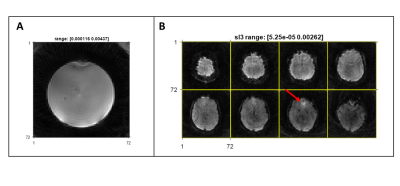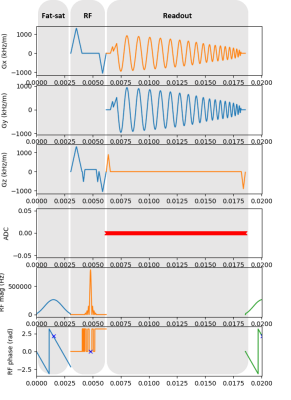Marina Manso Jimeno1,2, Sairam Geethanath1,2, Jon-Fredrik Nielsen3, and Douglas C. Noll3
1Columbia University, New York, NY, United States, 2Columbia Magnetic Resonance Research Center (CMRRC), New York, NY, United States, 3University of Michigan, Ann Arbor, MI, United States
1Columbia University, New York, NY, United States, 2Columbia Magnetic Resonance Research Center (CMRRC), New York, NY, United States, 3University of Michigan, Ann Arbor, MI, United States
We have successfully ported a spiral sequence for resting-state fMRI between two open-source and vendor-independent frameworks (TOPPE and Pulseq) in a cross-vendor manner. We have demonstrated the feasibility in vivo.

Figure 5: A) Slice of a fully sampled volume of the FBIRN phantom acquired using the spiral fMRI sequence in vendor 2. B) Eight slices of a fully sampled volume of the brain of a healthy volunteer acquired using the spiral fMRI sequence in vendor 2. The red arrow points to artifacts due to off-resonance effect on the prefrontal cortex.

Figure 3: pyPulseq’s Pulse sequence diagram. From top to bottom: gradients along the x-axis (Gx), y-axis (Gy), and z-axis (Gz) in kHz per meter, ADC, RF phase and RF magnitude in Hz and radians, respectively. The three grey areas represent the equivalent TOPPE modules for fat saturation pulse, RF slab excitation and spiral readout gradients.
